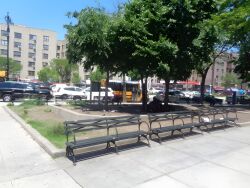Bergen Triangle
Bergen Triangle
This park was named in honor of William C. Bergen (1862-1925), a one-time policeman known as the “millionaire cop” because of the fortune he made buying vacant lots in the Bronx at the beginning of the 20th century. Bergen was a patrolman on the New York City Police Force and was assigned to the Bronx in 1905. Walking his beat, he often spotted large vacant areas that had remained undisturbed by subway lines. Seeing the potential of the undeveloped land, Bergen began buying portions of it with his life’s savings.
In 1900, the Third Avenue elevated line was extended into Fordham Plaza, and in 1918, the Jerome Avenue elevated line opened. After the arrival of the subway and the Bronx land boom, Bergen’s realty holdings skyrocketed in value. He sold several of the lots to developers and acquired a small fortune, enabling him to retire from the police force. Bergen embarked on a new career as one of the largest developers in the Bronx, building over two hundred houses on his remaining land. Later Bergen became a prominent figure in Bronx Democratic politics. On September 25, 1925, Bergen died of heart disease in Mount Sinai Hospital at the age of 63.
One of Bergen’s most notable achievements as a developer was the construction of the Bergen Building, built in 1915 at the intersection of Tremont and Arthur Avenues. The building evolved into a quasi-City Hall for the Bronx, and was later sold to the city for $800,000. Today, the building houses several city offices.
Bounded by Anthony Avenue, Grand Concourse, and East 181st Street, Bergen Park lies in the historic Fordham neighborhood in the northwestern Bronx. During the 17th century, a few houses stood near what is now the intersection of Bailey Avenue and Kingsbridge Road, and a nearby shallow crossing through the Harlem River was the only direct passage to the Bronx from Manhattan. In 1671, Governor Frances Lovelace (1621-1675) granted 3,900 acres of the land to Jon Archer, a Dutch settler, who named his new estate Fordham Manor after the Saxon words meaning “houses by the ford.” In 1693, the first bridge from the Bronx to Manhattan opened a short distance from the ford, and became known as King’s Bridge. During the American Revolution, the area was the site of many battles between the British and Americans. In the mid-1800s, a railroad line was extended into the area, St. John’s College (now Fordham University) was built, and the renowned writer Edgar Allan Poe (1809-1849) moved to the area. In 1913, the Poe Cottage (c. 1846) was moved to its present location in Poe Park, where the Bronx County Historical Society operates it as a museum.
The City of New York acquired the land that is now Bergen Park for street purposes by condemnation. After Anthony Avenue was completed, the Department of Highways transferred the leftover land to Parks on January 13, 1932. Soon thereafter, the traffic median opened as a small sitting park with bluestone curbing, cement sidewalks, Chrystie-Forsythe benches, shrubbery, and pin oak trees.
Check out your park's Vital Signs
Clean & Safe
Green & Resilient
Empowered & Engaged Users
Share your feedback or learn more about how this park is part of a
Vital Park System


